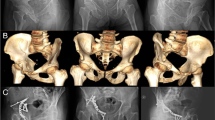Abstract
Objective:
Management of Morel-Lavallee soft tissue lesion (MLL) in patients with associated pelvic and/or acetabular fractures is still under discussion. Especially, the sequence of treatment of MLL soft tissue management and osteosynthesis of pelvic and acetabular injury remains controversial.
Methods:
We report all consecutive patients with MLL associated with pelvic ring and/or acetabular fractures during an 8-year period at our hospital. Surgical access and techniques were analyzed concerning complications and outcome.
Results:
Altogether, 20 patients were included in the study. One patient was treated conservatively and MLL healed without complications; 19 patients had an operative treatment of MLL. In 15 patients debridement was performed within one day after injury and in four patients with delay of 5 days at least. Ten patients had surgery for an associated pelvic ring or acetabular fracture. In four of them MLL was operated before, in six patients simultaneously to osteosynthesis. In three patients, the same surgical approach for osteosynthesis and debridement of MLL was used; none of them showed postoperative complications. Altogether, in nine operated patients (47.4%) MLL healed without any complications. Nine operated patients presented prolonged wound healing, however, during long term follow-up, all patients showed complete healing of the MLL. One patient died during resuscitive surgical procedures.
Conclusions:
We recommend debridement for early and delayed treatment of MLL. Osteosynthesis during first debridement may be performed without adverse outcome. Identical surgical access for both procedures can be used. In case of repeated surgical debridement VAC® therapy may be a helpful tool for dead space reduction and wound conditioning.
Similar content being viewed by others
References
Morel-Lavallee. Decollements traumatiques de la peau et des couches sous-jacentes. Arch Gen Med 1863;1:20–38, 172–200, 300–32.
Letournel E, Judet R. Fractures of the acetabulum. In: Elson RA, 2nd edn. Berlin: Springer; 1993:337, 363–97.
Hudson DA, Knottenbelt JD, Krige JEJ. Closed degloving injuries: results following conservative surgery. Plast Reconstr Surg 1992;89:853–855.
Harma A, Inan M, Ertem K. The Morel-Lavallee Lesion: a conservative approach to closed degloving injuries. Acta Orthop Traumatol Turc 2004;38:270–273.
Kottmeier SA, Wilson SC, Born CT, Hanks GA, Iannacone WM, DeLong WG. Surgical management of soft tissue lesions associated with pelvic ring injury. Clin Orthop Relat Res 1996;329:46–53.
Hak DJ, Olson SA, Matta JM. Diagnosis and management of closed internal degloving injuries associated with pelvic and acetabular fractures: the Morel-Lavallee lesion. J Trauma 1997;42:1046–1051.
Tseng S, Tornetta P. Percutaneous management of Morel-Lavallee lesions. J Bone Joint Surg 2006;88:92–96.
Parra JA, Fernandez MA, Encinas B, Rico M. Morel-Lavallee effusions in the thigh. Skeletal Radiol 1997;26:239–241.
Tscherne H, Pohlemann T. Unfallchirurgie. Bd. 7: Becken und Acetabulum. Springer, Berlin, 1998;S112–S115.
Letts RM. Degloving injuries in children. J Pediatr Orthop 1986;6:93–97.
Helfet DL, Schmeling GJ. Complications. In: Tile M (ed) Fractures of the pelvis and acetabulum. 2nd edn. Williams and Wilkins, Baltimore 1995, pp 451–467.
Kudsk KA, Sheldon GF, Walton RL. Degloving injuries of the extremities and torso. J Trauma 1981;21:835–839.
Matta J. Surgical treatment of acetabular fractures. In: Browner BD, Jupiter JB, Levine AM, Trafton PG (eds) Skeletal trauma. WB Saunders, Philadelphia 1992, pp 899–922.
Collicott PE, Hughes I. Training in advanced trauma support. JAMA 1980;293:1156–1159.
Baker SP, O’Neill B, Haddon W Jr, Long WB. The injury severity score: a method for describing patients with multiple injuries and evaluating emergency care. J Trauma 1974;14:187–196.
Champion HR, Copes WS, Sacco WJ, Lawnick MM, Keast SL, Bain LW Jr, Flanagan ME, Frey CF. The major trauma outcome study: establishing national norms for trauma care. J Trauma 1990;30:1356–1365.
Champion HR, Copes WS, Sacco WJ, Lawnick MM, Bain LW, Gann DS, Gennarelli T, Mackenzie E, Schwaitzberg S. A new characterization of injury severity. J Trauma 1990;30:539–545.
Rotondo MF, Schwab CW, McGonigal MD, Phillips GR 3rd, Fruchterman TM, Kauder DR, Latenser BA, Angood PA. Damage control: an approach for improved survival in exsanguinating penetrating abdominal injury. J Trauma 1993;35:375–382.
Shapiro MB, Jenkins DH, Schwab CW, Rotondo MF. Damage control: collective review. J Trauma 2000;49:969–978.
Argenta LC, Morykwas MJ. Vacuum-assisted closure: a new method for wound control and treatment: clinical experience. Ann Plast Surg 1997;38:563–576.
Morykwas MJ, Argenta LC, Shelton-Brown EI, McGuirt W. Vacuum-assisted closure: a new method for wound control and treatment: animal studies and basic foundation. Ann Plast Surg 1997;38:553–562.
Labler L, Trentz O. The use of vacuum assisted closure (VAC) in soft tissue injuries after high energy pelvic trauma. Langenbecks Arch Surg 2006; Epub ahead of print.
Parra JA, Fernandez MA, Encinas B, Rico M. Morel-Lavallee effusions in the thigh. Skeletal Radiol 1997;26:239–241.
Routt ML Jr, Simonian PT, Ballmer F. A rational approach to pelvic trauma. Resuscitation and early definitive stabilization. Clin Orthop Relat Res 1995;318:61–74.
Tsur A, Galin A, Kogan L, Loberant N. Morel-Lavallee syndrom after crush injury. Harefuah 2006;145:111–113.
Cormack GC, Lamberty BG. The blood supply of thigh skin. Plast Reconstr Surg 1985;75:342–354.
Aspects of Automotive Safety. Rating the severity of tissue damage. I. The abbreviated scale. JAMA 1971;215:277–280.
Pohlemann T. Pelvic ring injuries: assessment and concepts of surgical management. In: Ruedi TP, Murphy WM (eds) AO principles of fracture management. Thieme, Stuttgart 2000, pp 391–412.
Helfet DI, Barlett CS. Acetabular fractures: evaluation/classification/treatment concepts and approaches. In: Ruedi TP, Murphy WM (eds) AO principles of fracture management. Thieme, Stuttgart 2000, pp 415–439.
Author information
Authors and Affiliations
Corresponding author
Rights and permissions
About this article
Cite this article
Steiner, C.L., Trentz, O. & Labler, L. Management of Morel-Lavallee Lesion Associated with Pelvic and/or Acetabular Fractures. Eur J Trauma Emerg Surg 34, 554–560 (2008). https://doi.org/10.1007/s00068-007-7056-y
Received:
Accepted:
Published:
Issue Date:
DOI: https://doi.org/10.1007/s00068-007-7056-y




